Invest
Three signs the Aussie dollar is set to depreciate
Despite its resilience in recent months, the Australian dollar looks ready to depreciate in value relative to the US dollar, AMP Capital has said.
Three signs the Aussie dollar is set to depreciate
Despite its resilience in recent months, the Australian dollar looks ready to depreciate in value relative to the US dollar, AMP Capital has said.

The Australian dollar’s relative value has stayed steady between $0.72 and $0.78 US since January 2016, according to AMP Capital’s chief economist Shane Oliver, but this trend looks set to reverse for three key reasons.
- Prices for Australia’s commodity exports are on their way down
The price of Australia’s commodity exports, such as iron ore, coal, and metals, is a key driver for the Australian dollar, Mr Oliver said, with higher prices increasing the nation’s terms of trade (the ratio that measures the value of goods exported to the value of those imported and thus indicating how much capital a country is gaining or losing in a given time period).
“Raw material prices go through roughly 10-year upswings followed by 10 to 20 year downswings,” Mr Oliver said.
“These long-term moves reflect long lags in supply. For example, if commodity prices surge after years of undersupply, producers initially don’t believe it’s sustainable but, after several years, start to invest in new supply by which time the cycle is peaking.

“Then, when the new supply comes on stream, it accentuates the downswing and it all repeats in reverse.”
Resource projects have seen record investment recently, Mr Oliver said, and as a result have caused a “surge in supply”, placing Australia at the end of the upward swing in this commodity price cycle.
- The interest rate gap between Australia and the US will likely narrow
A country with a higher interest rate is a more attractive location for an investor to park their money, and subsequently experiences upward pressure on its currency, Mr Oliver explained.
Australia’s interest rate is currently at 1.5 per cent, somewhat higher that the 0.75-1.00 per cent rate in the US. However, the US Federal Reserve is expected to increase this twice more this year, in June and September, Mr Oliver said.
“This will take the Fed Funds rate to a range of 1.25-1.5 per cent.
“If the RBA leaves rates on hold at 1.5 per cent, which is our base case, then the gap between Australian and US official interest rates will have virtually closed by September.”
Historically, the Australian dollar has depreciated in value as the gap between the two countries’ interest rates has narrowed, Mr Oliver said.
- Current expectations for the dollar may be too high
According to Mr Oliver, speculative positions on the Australian dollar are currently long, meaning many investors expect the dollar’s value to rise, which leaves the currency even more vulnerable to softness in commodity prices, rate hikes in the US or cuts in Australia.

Cash
Cash usage in Australia continues to decline as digital payments rise
In the ever-evolving landscape of financial transactions, Australia is witnessing a significant shift away from cash, as revealed by Worldpay's latest Global Payments Report. According to the report, ...Read more

Cash
Navigating the equilibrium: Investor sentiment in the face of equity peaks and diminishing cash reserves
State Street's latest Risk Appetite Index indicates a nuanced shift in institutional investor sentiment during March, with the index reverting slightly towards neutrality. This subtle recalibration in ...Read more

Cash
RBA's November rate hike overshadows Melbourne Cup festivities
In a move that managed to draw attention away from the thrill of the Melbourne Cup, the Reserve Bank of Australia (RBA) has increased the cash rate by 25 basis points to 4.35 per cent, surprising ...Read more

Cash
RBA makes first cash rate call for 2022
The RBA has announced its first rate decision for 2022. Read more

Cash
Cash remains king for many Australians
Demand for banknotes remains high despite a decline in cash transactions. Read more

Cash
Interest rates to rise next year?
Commonwealth Bank has seconded Westpac’s predictions, forecasting that interest rates will rise well ahead of the RBA’s 2024 timeline. Read more

Cash
RBA makes latest official cash rate call
The Reserve Bank of Australia has made its May call on the official cash rate, with the economy said to be a long way from the conditions needed to precede a rate rise. Read more

Cash
RBA puts chatter of an earlier rate hike to rest
The Reserve Bank of Australia has put to rest chatter among investors that conditions for a higher cash rate could be met as early as next year, reaffirming its stance that the rate is “very likely” ...Read more

Cash
Cash usage in Australia continues to decline as digital payments rise
In the ever-evolving landscape of financial transactions, Australia is witnessing a significant shift away from cash, as revealed by Worldpay's latest Global Payments Report. According to the report, ...Read more

Cash
Navigating the equilibrium: Investor sentiment in the face of equity peaks and diminishing cash reserves
State Street's latest Risk Appetite Index indicates a nuanced shift in institutional investor sentiment during March, with the index reverting slightly towards neutrality. This subtle recalibration in ...Read more

Cash
RBA's November rate hike overshadows Melbourne Cup festivities
In a move that managed to draw attention away from the thrill of the Melbourne Cup, the Reserve Bank of Australia (RBA) has increased the cash rate by 25 basis points to 4.35 per cent, surprising ...Read more

Cash
RBA makes first cash rate call for 2022
The RBA has announced its first rate decision for 2022. Read more

Cash
Cash remains king for many Australians
Demand for banknotes remains high despite a decline in cash transactions. Read more

Cash
Interest rates to rise next year?
Commonwealth Bank has seconded Westpac’s predictions, forecasting that interest rates will rise well ahead of the RBA’s 2024 timeline. Read more

Cash
RBA makes latest official cash rate call
The Reserve Bank of Australia has made its May call on the official cash rate, with the economy said to be a long way from the conditions needed to precede a rate rise. Read more

Cash
RBA puts chatter of an earlier rate hike to rest
The Reserve Bank of Australia has put to rest chatter among investors that conditions for a higher cash rate could be met as early as next year, reaffirming its stance that the rate is “very likely” ...Read more








